University Assignment: Logistics, TBL, and Sustainability Strategies
VerifiedAdded on 2022/10/11
|9
|2631
|38
Report
AI Summary
This report examines the relationship between effective logistics management and sustainability, focusing on the Triple Bottom Line (TBL) framework, which integrates social, environmental, and financial performance dimensions. The introduction highlights the increasing importance of sustainability in business operations, especially within the supply chain and logistics sectors. The report defines and explains the TBL concept, detailing its three dimensions: People (social), Planet (environmental), and Profit (economic). It then defines logistics management and its key components, such as transportation, warehousing, and inventory control. The core of the report analyzes how efficient logistics management contributes to TBL sustainability, including examples of emission reduction, waste product reduction, energy consumption reduction, alignment with governmental regulations, and increased customer awareness. The report concludes by emphasizing the importance of sustainable logistics management for companies in the face of growing international trade and consumer demand, and underscores the initiatives businesses can take to integrate TBL approach into their supply chains, balancing profitability with environmental and social responsibilities.
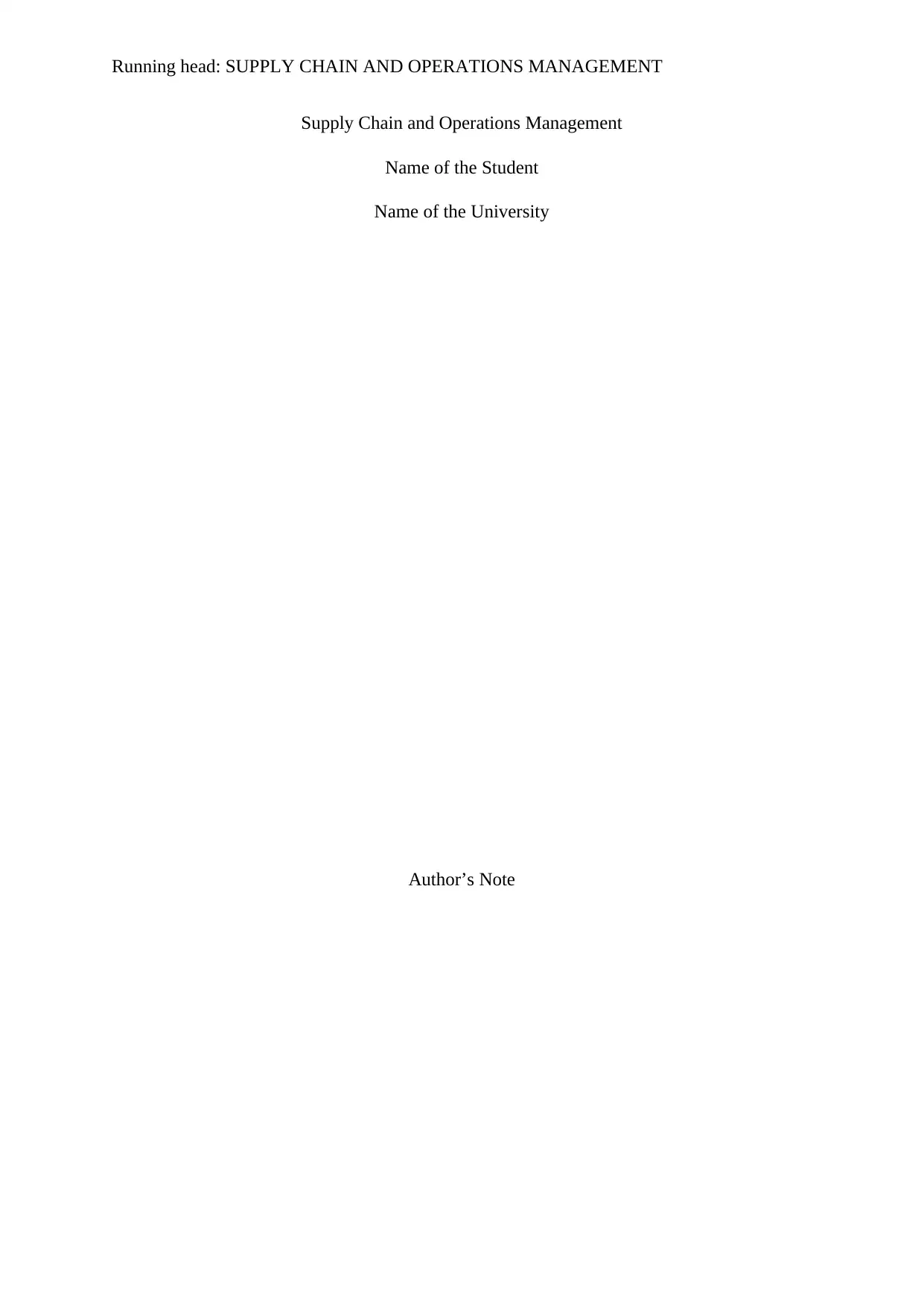
Running head: SUPPLY CHAIN AND OPERATIONS MANAGEMENT
Supply Chain and Operations Management
Name of the Student
Name of the University
Author’s Note
Supply Chain and Operations Management
Name of the Student
Name of the University
Author’s Note
Paraphrase This Document
Need a fresh take? Get an instant paraphrase of this document with our AI Paraphraser
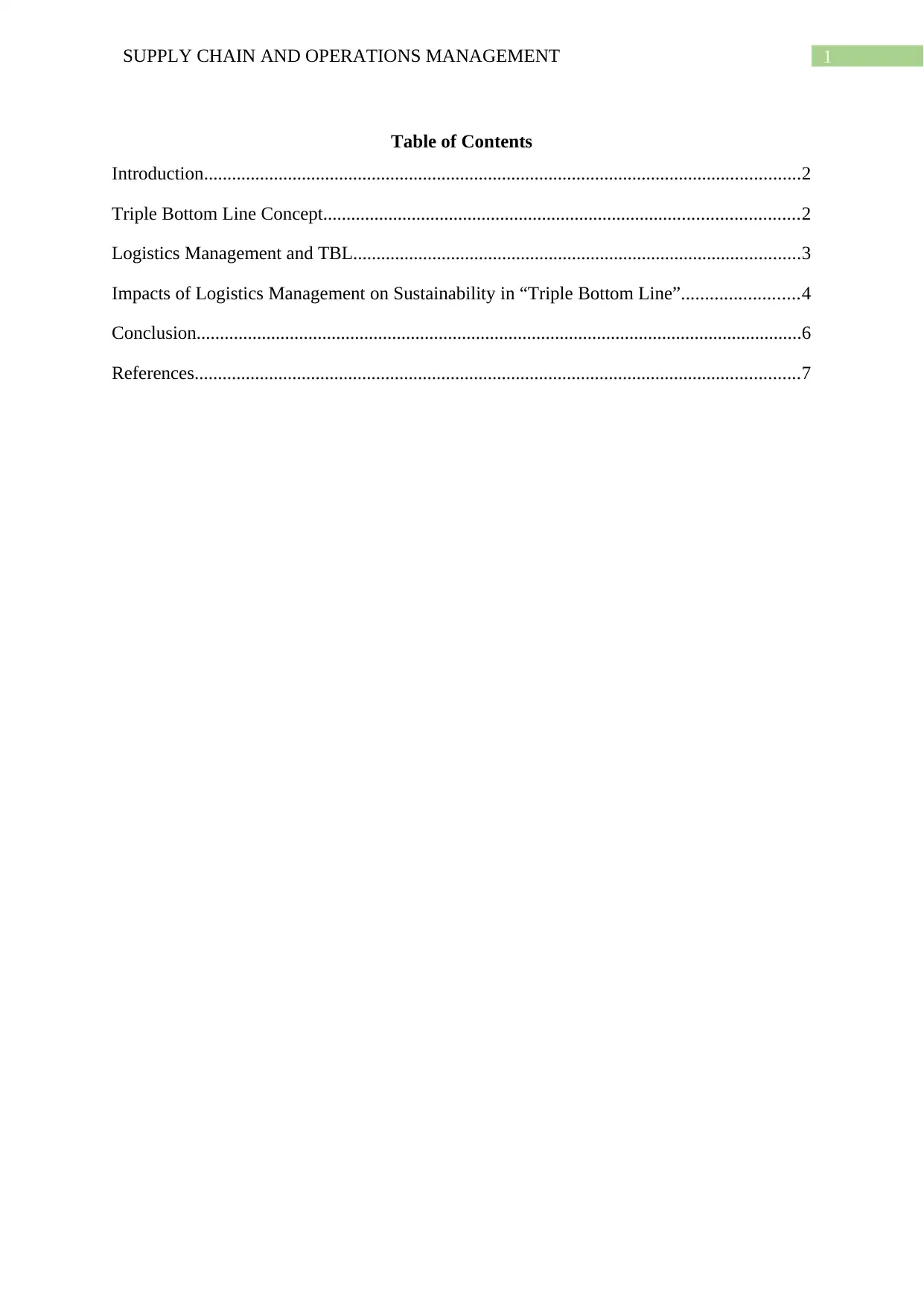
1SUPPLY CHAIN AND OPERATIONS MANAGEMENT
Table of Contents
Introduction................................................................................................................................2
Triple Bottom Line Concept......................................................................................................2
Logistics Management and TBL................................................................................................3
Impacts of Logistics Management on Sustainability in “Triple Bottom Line”.........................4
Conclusion..................................................................................................................................6
References..................................................................................................................................7
Table of Contents
Introduction................................................................................................................................2
Triple Bottom Line Concept......................................................................................................2
Logistics Management and TBL................................................................................................3
Impacts of Logistics Management on Sustainability in “Triple Bottom Line”.........................4
Conclusion..................................................................................................................................6
References..................................................................................................................................7
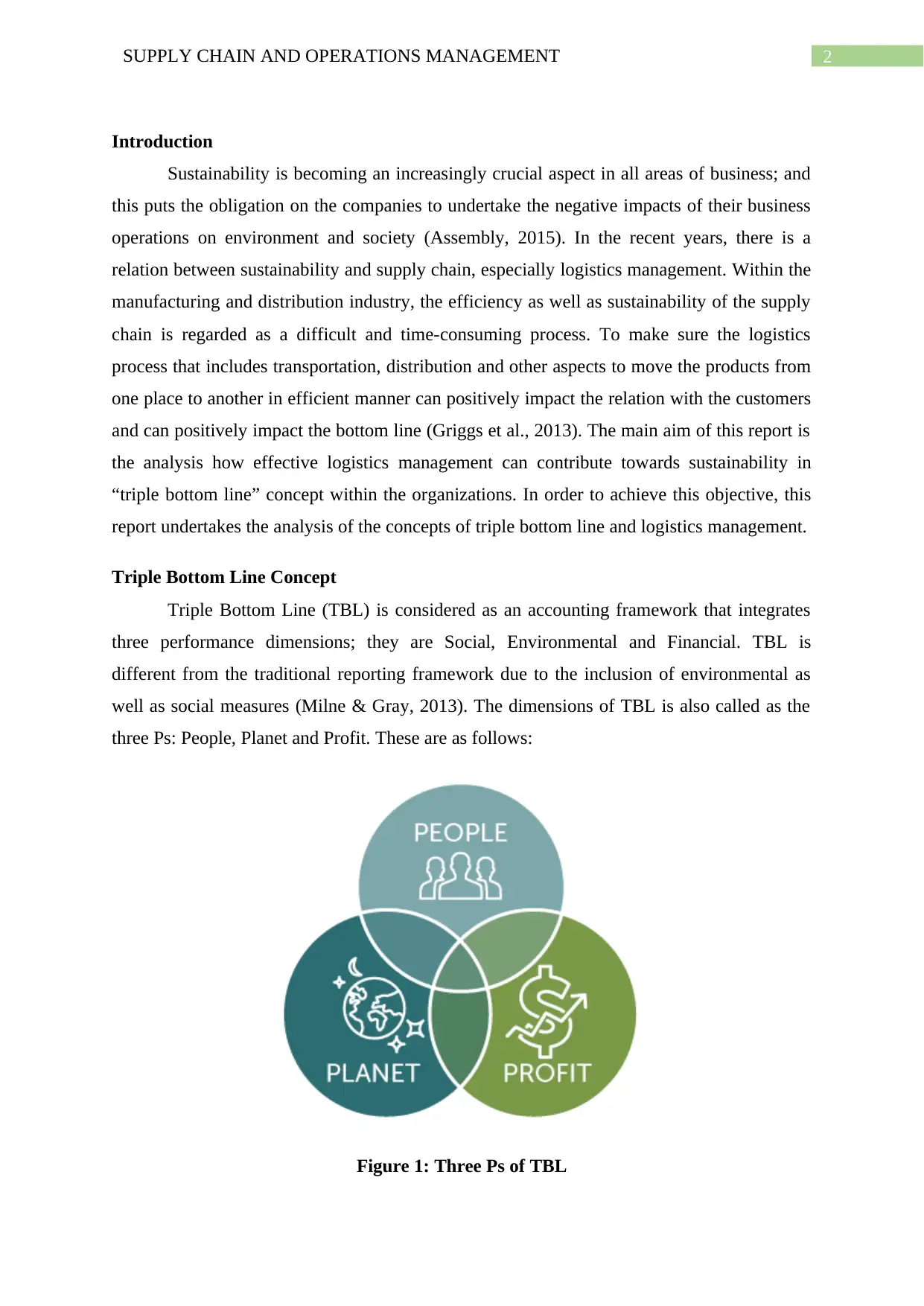
2SUPPLY CHAIN AND OPERATIONS MANAGEMENT
Introduction
Sustainability is becoming an increasingly crucial aspect in all areas of business; and
this puts the obligation on the companies to undertake the negative impacts of their business
operations on environment and society (Assembly, 2015). In the recent years, there is a
relation between sustainability and supply chain, especially logistics management. Within the
manufacturing and distribution industry, the efficiency as well as sustainability of the supply
chain is regarded as a difficult and time-consuming process. To make sure the logistics
process that includes transportation, distribution and other aspects to move the products from
one place to another in efficient manner can positively impact the relation with the customers
and can positively impact the bottom line (Griggs et al., 2013). The main aim of this report is
the analysis how effective logistics management can contribute towards sustainability in
“triple bottom line” concept within the organizations. In order to achieve this objective, this
report undertakes the analysis of the concepts of triple bottom line and logistics management.
Triple Bottom Line Concept
Triple Bottom Line (TBL) is considered as an accounting framework that integrates
three performance dimensions; they are Social, Environmental and Financial. TBL is
different from the traditional reporting framework due to the inclusion of environmental as
well as social measures (Milne & Gray, 2013). The dimensions of TBL is also called as the
three Ps: People, Planet and Profit. These are as follows:
Figure 1: Three Ps of TBL
Introduction
Sustainability is becoming an increasingly crucial aspect in all areas of business; and
this puts the obligation on the companies to undertake the negative impacts of their business
operations on environment and society (Assembly, 2015). In the recent years, there is a
relation between sustainability and supply chain, especially logistics management. Within the
manufacturing and distribution industry, the efficiency as well as sustainability of the supply
chain is regarded as a difficult and time-consuming process. To make sure the logistics
process that includes transportation, distribution and other aspects to move the products from
one place to another in efficient manner can positively impact the relation with the customers
and can positively impact the bottom line (Griggs et al., 2013). The main aim of this report is
the analysis how effective logistics management can contribute towards sustainability in
“triple bottom line” concept within the organizations. In order to achieve this objective, this
report undertakes the analysis of the concepts of triple bottom line and logistics management.
Triple Bottom Line Concept
Triple Bottom Line (TBL) is considered as an accounting framework that integrates
three performance dimensions; they are Social, Environmental and Financial. TBL is
different from the traditional reporting framework due to the inclusion of environmental as
well as social measures (Milne & Gray, 2013). The dimensions of TBL is also called as the
three Ps: People, Planet and Profit. These are as follows:
Figure 1: Three Ps of TBL
⊘ This is a preview!⊘
Do you want full access?
Subscribe today to unlock all pages.

Trusted by 1+ million students worldwide
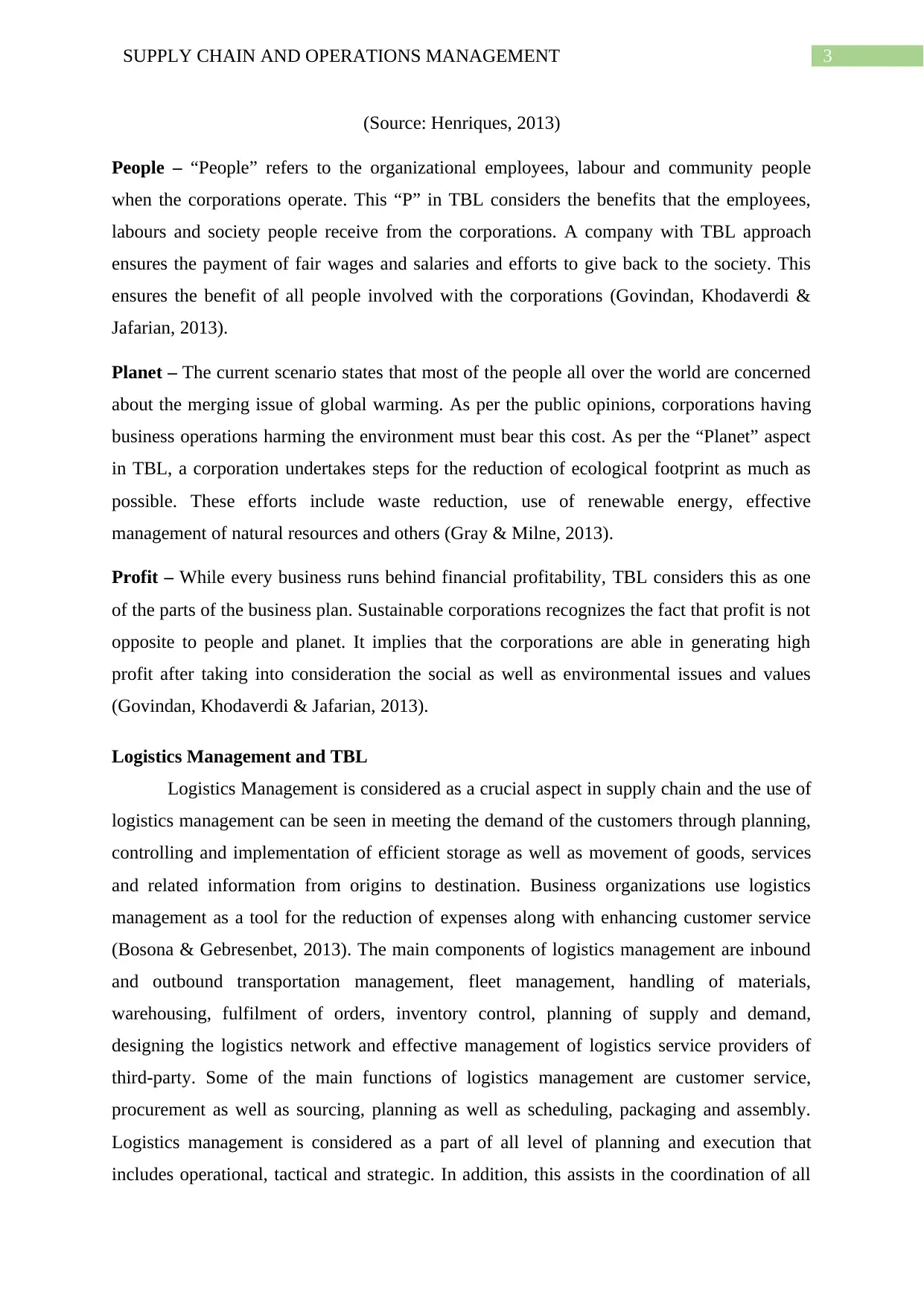
3SUPPLY CHAIN AND OPERATIONS MANAGEMENT
(Source: Henriques, 2013)
People – “People” refers to the organizational employees, labour and community people
when the corporations operate. This “P” in TBL considers the benefits that the employees,
labours and society people receive from the corporations. A company with TBL approach
ensures the payment of fair wages and salaries and efforts to give back to the society. This
ensures the benefit of all people involved with the corporations (Govindan, Khodaverdi &
Jafarian, 2013).
Planet – The current scenario states that most of the people all over the world are concerned
about the merging issue of global warming. As per the public opinions, corporations having
business operations harming the environment must bear this cost. As per the “Planet” aspect
in TBL, a corporation undertakes steps for the reduction of ecological footprint as much as
possible. These efforts include waste reduction, use of renewable energy, effective
management of natural resources and others (Gray & Milne, 2013).
Profit – While every business runs behind financial profitability, TBL considers this as one
of the parts of the business plan. Sustainable corporations recognizes the fact that profit is not
opposite to people and planet. It implies that the corporations are able in generating high
profit after taking into consideration the social as well as environmental issues and values
(Govindan, Khodaverdi & Jafarian, 2013).
Logistics Management and TBL
Logistics Management is considered as a crucial aspect in supply chain and the use of
logistics management can be seen in meeting the demand of the customers through planning,
controlling and implementation of efficient storage as well as movement of goods, services
and related information from origins to destination. Business organizations use logistics
management as a tool for the reduction of expenses along with enhancing customer service
(Bosona & Gebresenbet, 2013). The main components of logistics management are inbound
and outbound transportation management, fleet management, handling of materials,
warehousing, fulfilment of orders, inventory control, planning of supply and demand,
designing the logistics network and effective management of logistics service providers of
third-party. Some of the main functions of logistics management are customer service,
procurement as well as sourcing, planning as well as scheduling, packaging and assembly.
Logistics management is considered as a part of all level of planning and execution that
includes operational, tactical and strategic. In addition, this assists in the coordination of all
(Source: Henriques, 2013)
People – “People” refers to the organizational employees, labour and community people
when the corporations operate. This “P” in TBL considers the benefits that the employees,
labours and society people receive from the corporations. A company with TBL approach
ensures the payment of fair wages and salaries and efforts to give back to the society. This
ensures the benefit of all people involved with the corporations (Govindan, Khodaverdi &
Jafarian, 2013).
Planet – The current scenario states that most of the people all over the world are concerned
about the merging issue of global warming. As per the public opinions, corporations having
business operations harming the environment must bear this cost. As per the “Planet” aspect
in TBL, a corporation undertakes steps for the reduction of ecological footprint as much as
possible. These efforts include waste reduction, use of renewable energy, effective
management of natural resources and others (Gray & Milne, 2013).
Profit – While every business runs behind financial profitability, TBL considers this as one
of the parts of the business plan. Sustainable corporations recognizes the fact that profit is not
opposite to people and planet. It implies that the corporations are able in generating high
profit after taking into consideration the social as well as environmental issues and values
(Govindan, Khodaverdi & Jafarian, 2013).
Logistics Management and TBL
Logistics Management is considered as a crucial aspect in supply chain and the use of
logistics management can be seen in meeting the demand of the customers through planning,
controlling and implementation of efficient storage as well as movement of goods, services
and related information from origins to destination. Business organizations use logistics
management as a tool for the reduction of expenses along with enhancing customer service
(Bosona & Gebresenbet, 2013). The main components of logistics management are inbound
and outbound transportation management, fleet management, handling of materials,
warehousing, fulfilment of orders, inventory control, planning of supply and demand,
designing the logistics network and effective management of logistics service providers of
third-party. Some of the main functions of logistics management are customer service,
procurement as well as sourcing, planning as well as scheduling, packaging and assembly.
Logistics management is considered as a part of all level of planning and execution that
includes operational, tactical and strategic. In addition, this assists in the coordination of all
Paraphrase This Document
Need a fresh take? Get an instant paraphrase of this document with our AI Paraphraser
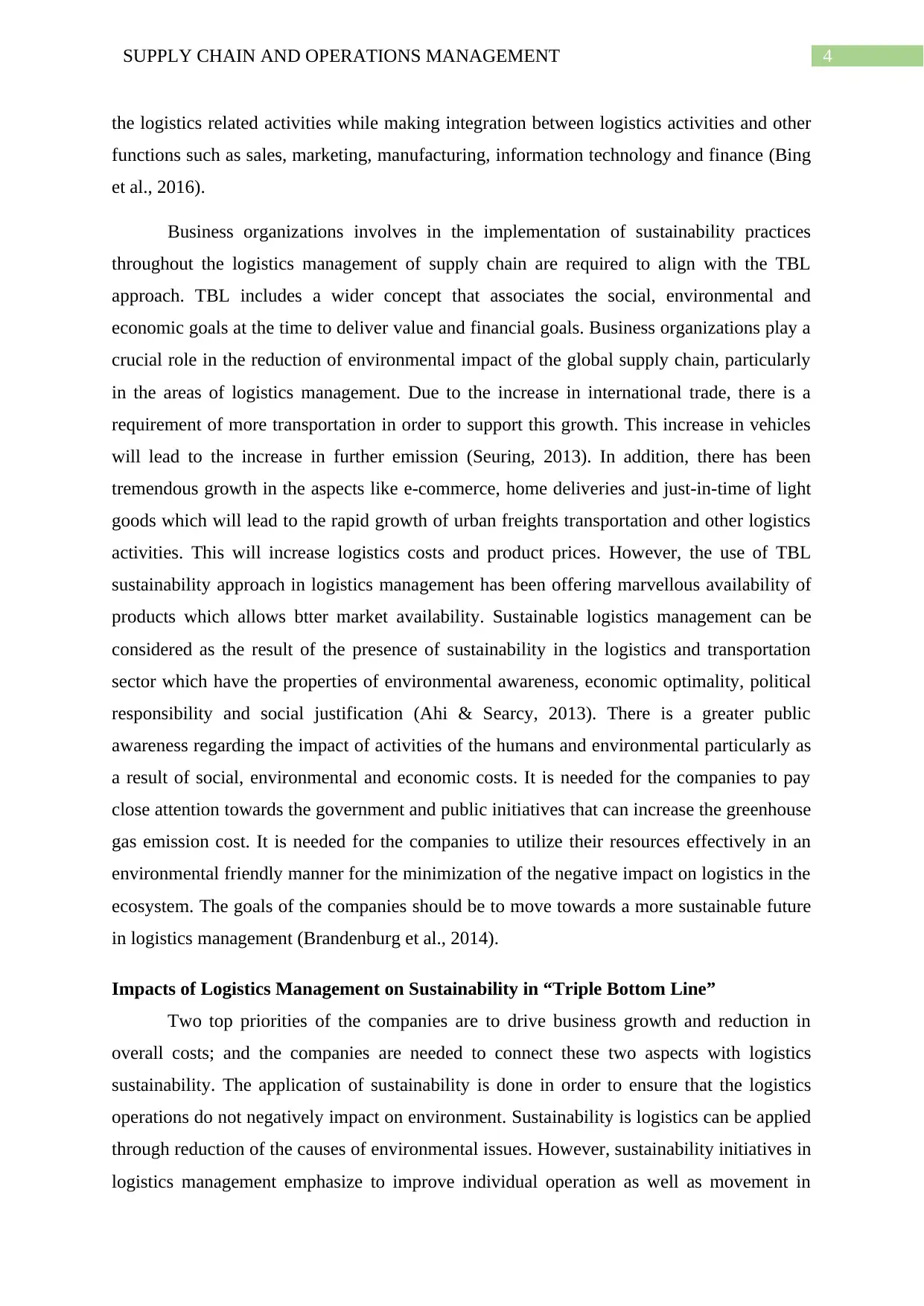
4SUPPLY CHAIN AND OPERATIONS MANAGEMENT
the logistics related activities while making integration between logistics activities and other
functions such as sales, marketing, manufacturing, information technology and finance (Bing
et al., 2016).
Business organizations involves in the implementation of sustainability practices
throughout the logistics management of supply chain are required to align with the TBL
approach. TBL includes a wider concept that associates the social, environmental and
economic goals at the time to deliver value and financial goals. Business organizations play a
crucial role in the reduction of environmental impact of the global supply chain, particularly
in the areas of logistics management. Due to the increase in international trade, there is a
requirement of more transportation in order to support this growth. This increase in vehicles
will lead to the increase in further emission (Seuring, 2013). In addition, there has been
tremendous growth in the aspects like e-commerce, home deliveries and just-in-time of light
goods which will lead to the rapid growth of urban freights transportation and other logistics
activities. This will increase logistics costs and product prices. However, the use of TBL
sustainability approach in logistics management has been offering marvellous availability of
products which allows btter market availability. Sustainable logistics management can be
considered as the result of the presence of sustainability in the logistics and transportation
sector which have the properties of environmental awareness, economic optimality, political
responsibility and social justification (Ahi & Searcy, 2013). There is a greater public
awareness regarding the impact of activities of the humans and environmental particularly as
a result of social, environmental and economic costs. It is needed for the companies to pay
close attention towards the government and public initiatives that can increase the greenhouse
gas emission cost. It is needed for the companies to utilize their resources effectively in an
environmental friendly manner for the minimization of the negative impact on logistics in the
ecosystem. The goals of the companies should be to move towards a more sustainable future
in logistics management (Brandenburg et al., 2014).
Impacts of Logistics Management on Sustainability in “Triple Bottom Line”
Two top priorities of the companies are to drive business growth and reduction in
overall costs; and the companies are needed to connect these two aspects with logistics
sustainability. The application of sustainability is done in order to ensure that the logistics
operations do not negatively impact on environment. Sustainability is logistics can be applied
through reduction of the causes of environmental issues. However, sustainability initiatives in
logistics management emphasize to improve individual operation as well as movement in
the logistics related activities while making integration between logistics activities and other
functions such as sales, marketing, manufacturing, information technology and finance (Bing
et al., 2016).
Business organizations involves in the implementation of sustainability practices
throughout the logistics management of supply chain are required to align with the TBL
approach. TBL includes a wider concept that associates the social, environmental and
economic goals at the time to deliver value and financial goals. Business organizations play a
crucial role in the reduction of environmental impact of the global supply chain, particularly
in the areas of logistics management. Due to the increase in international trade, there is a
requirement of more transportation in order to support this growth. This increase in vehicles
will lead to the increase in further emission (Seuring, 2013). In addition, there has been
tremendous growth in the aspects like e-commerce, home deliveries and just-in-time of light
goods which will lead to the rapid growth of urban freights transportation and other logistics
activities. This will increase logistics costs and product prices. However, the use of TBL
sustainability approach in logistics management has been offering marvellous availability of
products which allows btter market availability. Sustainable logistics management can be
considered as the result of the presence of sustainability in the logistics and transportation
sector which have the properties of environmental awareness, economic optimality, political
responsibility and social justification (Ahi & Searcy, 2013). There is a greater public
awareness regarding the impact of activities of the humans and environmental particularly as
a result of social, environmental and economic costs. It is needed for the companies to pay
close attention towards the government and public initiatives that can increase the greenhouse
gas emission cost. It is needed for the companies to utilize their resources effectively in an
environmental friendly manner for the minimization of the negative impact on logistics in the
ecosystem. The goals of the companies should be to move towards a more sustainable future
in logistics management (Brandenburg et al., 2014).
Impacts of Logistics Management on Sustainability in “Triple Bottom Line”
Two top priorities of the companies are to drive business growth and reduction in
overall costs; and the companies are needed to connect these two aspects with logistics
sustainability. The application of sustainability is done in order to ensure that the logistics
operations do not negatively impact on environment. Sustainability is logistics can be applied
through reduction of the causes of environmental issues. However, sustainability initiatives in
logistics management emphasize to improve individual operation as well as movement in
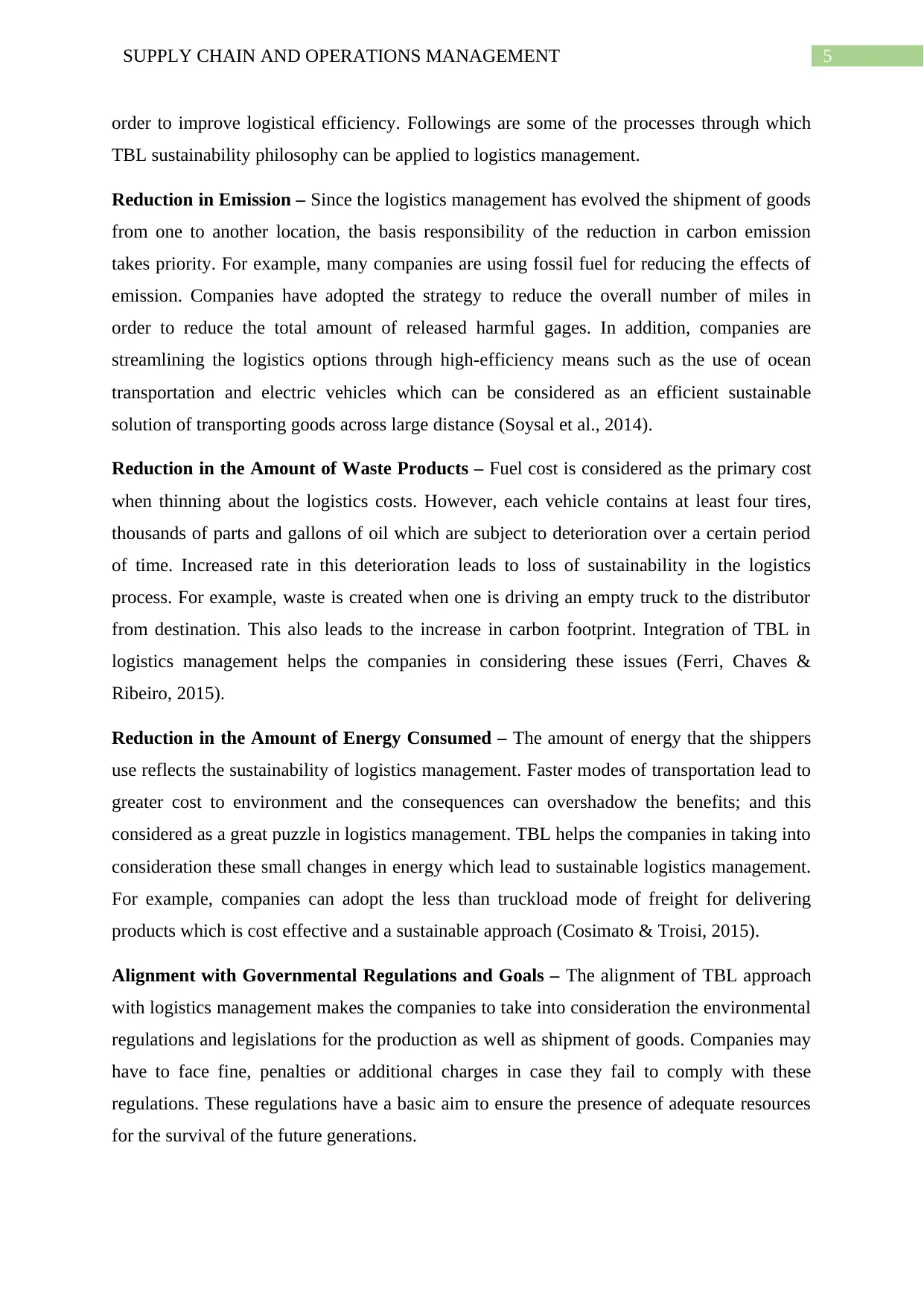
5SUPPLY CHAIN AND OPERATIONS MANAGEMENT
order to improve logistical efficiency. Followings are some of the processes through which
TBL sustainability philosophy can be applied to logistics management.
Reduction in Emission – Since the logistics management has evolved the shipment of goods
from one to another location, the basis responsibility of the reduction in carbon emission
takes priority. For example, many companies are using fossil fuel for reducing the effects of
emission. Companies have adopted the strategy to reduce the overall number of miles in
order to reduce the total amount of released harmful gages. In addition, companies are
streamlining the logistics options through high-efficiency means such as the use of ocean
transportation and electric vehicles which can be considered as an efficient sustainable
solution of transporting goods across large distance (Soysal et al., 2014).
Reduction in the Amount of Waste Products – Fuel cost is considered as the primary cost
when thinning about the logistics costs. However, each vehicle contains at least four tires,
thousands of parts and gallons of oil which are subject to deterioration over a certain period
of time. Increased rate in this deterioration leads to loss of sustainability in the logistics
process. For example, waste is created when one is driving an empty truck to the distributor
from destination. This also leads to the increase in carbon footprint. Integration of TBL in
logistics management helps the companies in considering these issues (Ferri, Chaves &
Ribeiro, 2015).
Reduction in the Amount of Energy Consumed – The amount of energy that the shippers
use reflects the sustainability of logistics management. Faster modes of transportation lead to
greater cost to environment and the consequences can overshadow the benefits; and this
considered as a great puzzle in logistics management. TBL helps the companies in taking into
consideration these small changes in energy which lead to sustainable logistics management.
For example, companies can adopt the less than truckload mode of freight for delivering
products which is cost effective and a sustainable approach (Cosimato & Troisi, 2015).
Alignment with Governmental Regulations and Goals – The alignment of TBL approach
with logistics management makes the companies to take into consideration the environmental
regulations and legislations for the production as well as shipment of goods. Companies may
have to face fine, penalties or additional charges in case they fail to comply with these
regulations. These regulations have a basic aim to ensure the presence of adequate resources
for the survival of the future generations.
order to improve logistical efficiency. Followings are some of the processes through which
TBL sustainability philosophy can be applied to logistics management.
Reduction in Emission – Since the logistics management has evolved the shipment of goods
from one to another location, the basis responsibility of the reduction in carbon emission
takes priority. For example, many companies are using fossil fuel for reducing the effects of
emission. Companies have adopted the strategy to reduce the overall number of miles in
order to reduce the total amount of released harmful gages. In addition, companies are
streamlining the logistics options through high-efficiency means such as the use of ocean
transportation and electric vehicles which can be considered as an efficient sustainable
solution of transporting goods across large distance (Soysal et al., 2014).
Reduction in the Amount of Waste Products – Fuel cost is considered as the primary cost
when thinning about the logistics costs. However, each vehicle contains at least four tires,
thousands of parts and gallons of oil which are subject to deterioration over a certain period
of time. Increased rate in this deterioration leads to loss of sustainability in the logistics
process. For example, waste is created when one is driving an empty truck to the distributor
from destination. This also leads to the increase in carbon footprint. Integration of TBL in
logistics management helps the companies in considering these issues (Ferri, Chaves &
Ribeiro, 2015).
Reduction in the Amount of Energy Consumed – The amount of energy that the shippers
use reflects the sustainability of logistics management. Faster modes of transportation lead to
greater cost to environment and the consequences can overshadow the benefits; and this
considered as a great puzzle in logistics management. TBL helps the companies in taking into
consideration these small changes in energy which lead to sustainable logistics management.
For example, companies can adopt the less than truckload mode of freight for delivering
products which is cost effective and a sustainable approach (Cosimato & Troisi, 2015).
Alignment with Governmental Regulations and Goals – The alignment of TBL approach
with logistics management makes the companies to take into consideration the environmental
regulations and legislations for the production as well as shipment of goods. Companies may
have to face fine, penalties or additional charges in case they fail to comply with these
regulations. These regulations have a basic aim to ensure the presence of adequate resources
for the survival of the future generations.
⊘ This is a preview!⊘
Do you want full access?
Subscribe today to unlock all pages.

Trusted by 1+ million students worldwide
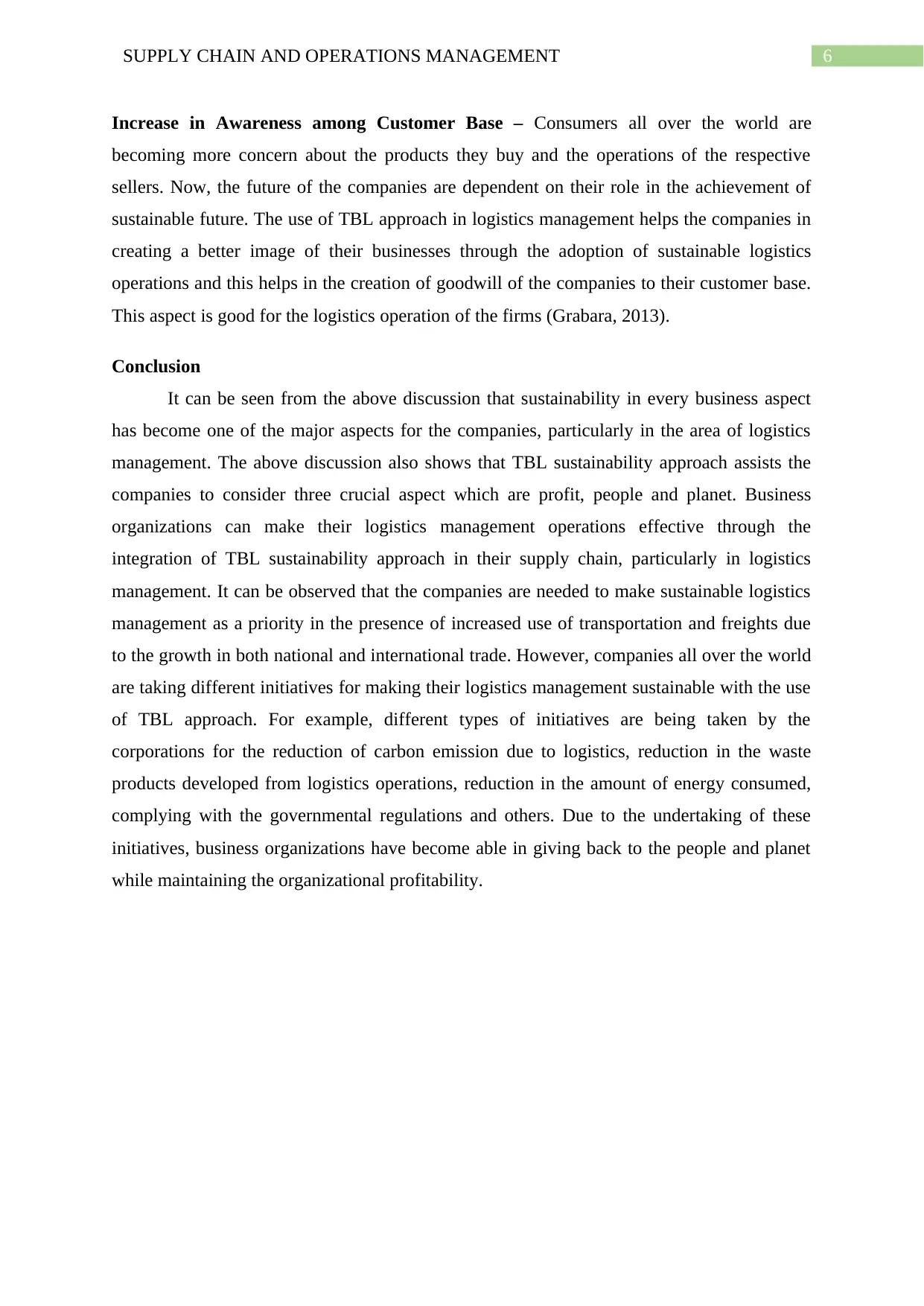
6SUPPLY CHAIN AND OPERATIONS MANAGEMENT
Increase in Awareness among Customer Base – Consumers all over the world are
becoming more concern about the products they buy and the operations of the respective
sellers. Now, the future of the companies are dependent on their role in the achievement of
sustainable future. The use of TBL approach in logistics management helps the companies in
creating a better image of their businesses through the adoption of sustainable logistics
operations and this helps in the creation of goodwill of the companies to their customer base.
This aspect is good for the logistics operation of the firms (Grabara, 2013).
Conclusion
It can be seen from the above discussion that sustainability in every business aspect
has become one of the major aspects for the companies, particularly in the area of logistics
management. The above discussion also shows that TBL sustainability approach assists the
companies to consider three crucial aspect which are profit, people and planet. Business
organizations can make their logistics management operations effective through the
integration of TBL sustainability approach in their supply chain, particularly in logistics
management. It can be observed that the companies are needed to make sustainable logistics
management as a priority in the presence of increased use of transportation and freights due
to the growth in both national and international trade. However, companies all over the world
are taking different initiatives for making their logistics management sustainable with the use
of TBL approach. For example, different types of initiatives are being taken by the
corporations for the reduction of carbon emission due to logistics, reduction in the waste
products developed from logistics operations, reduction in the amount of energy consumed,
complying with the governmental regulations and others. Due to the undertaking of these
initiatives, business organizations have become able in giving back to the people and planet
while maintaining the organizational profitability.
Increase in Awareness among Customer Base – Consumers all over the world are
becoming more concern about the products they buy and the operations of the respective
sellers. Now, the future of the companies are dependent on their role in the achievement of
sustainable future. The use of TBL approach in logistics management helps the companies in
creating a better image of their businesses through the adoption of sustainable logistics
operations and this helps in the creation of goodwill of the companies to their customer base.
This aspect is good for the logistics operation of the firms (Grabara, 2013).
Conclusion
It can be seen from the above discussion that sustainability in every business aspect
has become one of the major aspects for the companies, particularly in the area of logistics
management. The above discussion also shows that TBL sustainability approach assists the
companies to consider three crucial aspect which are profit, people and planet. Business
organizations can make their logistics management operations effective through the
integration of TBL sustainability approach in their supply chain, particularly in logistics
management. It can be observed that the companies are needed to make sustainable logistics
management as a priority in the presence of increased use of transportation and freights due
to the growth in both national and international trade. However, companies all over the world
are taking different initiatives for making their logistics management sustainable with the use
of TBL approach. For example, different types of initiatives are being taken by the
corporations for the reduction of carbon emission due to logistics, reduction in the waste
products developed from logistics operations, reduction in the amount of energy consumed,
complying with the governmental regulations and others. Due to the undertaking of these
initiatives, business organizations have become able in giving back to the people and planet
while maintaining the organizational profitability.
Paraphrase This Document
Need a fresh take? Get an instant paraphrase of this document with our AI Paraphraser
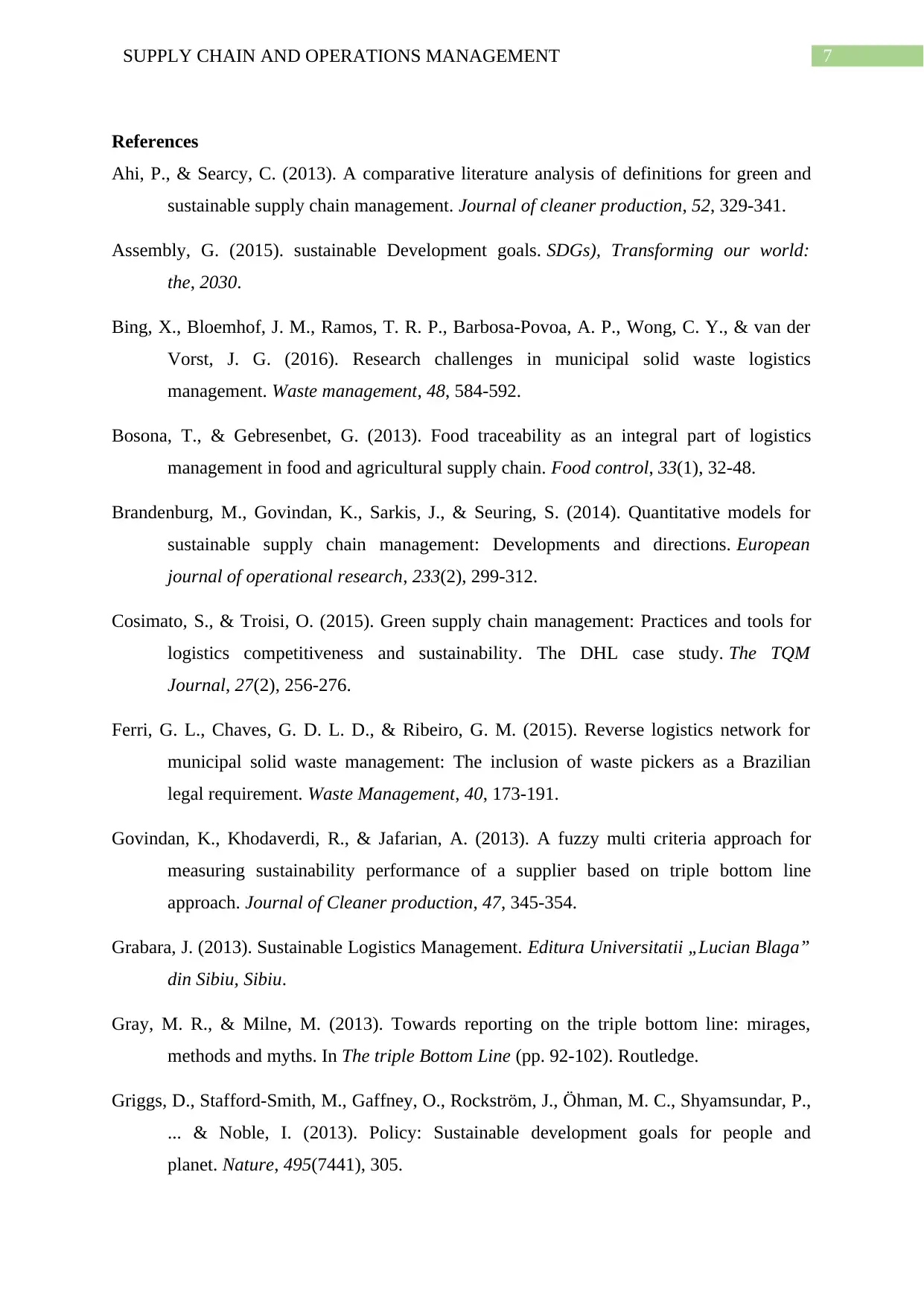
7SUPPLY CHAIN AND OPERATIONS MANAGEMENT
References
Ahi, P., & Searcy, C. (2013). A comparative literature analysis of definitions for green and
sustainable supply chain management. Journal of cleaner production, 52, 329-341.
Assembly, G. (2015). sustainable Development goals. SDGs), Transforming our world:
the, 2030.
Bing, X., Bloemhof, J. M., Ramos, T. R. P., Barbosa-Povoa, A. P., Wong, C. Y., & van der
Vorst, J. G. (2016). Research challenges in municipal solid waste logistics
management. Waste management, 48, 584-592.
Bosona, T., & Gebresenbet, G. (2013). Food traceability as an integral part of logistics
management in food and agricultural supply chain. Food control, 33(1), 32-48.
Brandenburg, M., Govindan, K., Sarkis, J., & Seuring, S. (2014). Quantitative models for
sustainable supply chain management: Developments and directions. European
journal of operational research, 233(2), 299-312.
Cosimato, S., & Troisi, O. (2015). Green supply chain management: Practices and tools for
logistics competitiveness and sustainability. The DHL case study. The TQM
Journal, 27(2), 256-276.
Ferri, G. L., Chaves, G. D. L. D., & Ribeiro, G. M. (2015). Reverse logistics network for
municipal solid waste management: The inclusion of waste pickers as a Brazilian
legal requirement. Waste Management, 40, 173-191.
Govindan, K., Khodaverdi, R., & Jafarian, A. (2013). A fuzzy multi criteria approach for
measuring sustainability performance of a supplier based on triple bottom line
approach. Journal of Cleaner production, 47, 345-354.
Grabara, J. (2013). Sustainable Logistics Management. Editura Universitatii „Lucian Blaga”
din Sibiu, Sibiu.
Gray, M. R., & Milne, M. (2013). Towards reporting on the triple bottom line: mirages,
methods and myths. In The triple Bottom Line (pp. 92-102). Routledge.
Griggs, D., Stafford-Smith, M., Gaffney, O., Rockström, J., Öhman, M. C., Shyamsundar, P.,
... & Noble, I. (2013). Policy: Sustainable development goals for people and
planet. Nature, 495(7441), 305.
References
Ahi, P., & Searcy, C. (2013). A comparative literature analysis of definitions for green and
sustainable supply chain management. Journal of cleaner production, 52, 329-341.
Assembly, G. (2015). sustainable Development goals. SDGs), Transforming our world:
the, 2030.
Bing, X., Bloemhof, J. M., Ramos, T. R. P., Barbosa-Povoa, A. P., Wong, C. Y., & van der
Vorst, J. G. (2016). Research challenges in municipal solid waste logistics
management. Waste management, 48, 584-592.
Bosona, T., & Gebresenbet, G. (2013). Food traceability as an integral part of logistics
management in food and agricultural supply chain. Food control, 33(1), 32-48.
Brandenburg, M., Govindan, K., Sarkis, J., & Seuring, S. (2014). Quantitative models for
sustainable supply chain management: Developments and directions. European
journal of operational research, 233(2), 299-312.
Cosimato, S., & Troisi, O. (2015). Green supply chain management: Practices and tools for
logistics competitiveness and sustainability. The DHL case study. The TQM
Journal, 27(2), 256-276.
Ferri, G. L., Chaves, G. D. L. D., & Ribeiro, G. M. (2015). Reverse logistics network for
municipal solid waste management: The inclusion of waste pickers as a Brazilian
legal requirement. Waste Management, 40, 173-191.
Govindan, K., Khodaverdi, R., & Jafarian, A. (2013). A fuzzy multi criteria approach for
measuring sustainability performance of a supplier based on triple bottom line
approach. Journal of Cleaner production, 47, 345-354.
Grabara, J. (2013). Sustainable Logistics Management. Editura Universitatii „Lucian Blaga”
din Sibiu, Sibiu.
Gray, M. R., & Milne, M. (2013). Towards reporting on the triple bottom line: mirages,
methods and myths. In The triple Bottom Line (pp. 92-102). Routledge.
Griggs, D., Stafford-Smith, M., Gaffney, O., Rockström, J., Öhman, M. C., Shyamsundar, P.,
... & Noble, I. (2013). Policy: Sustainable development goals for people and
planet. Nature, 495(7441), 305.
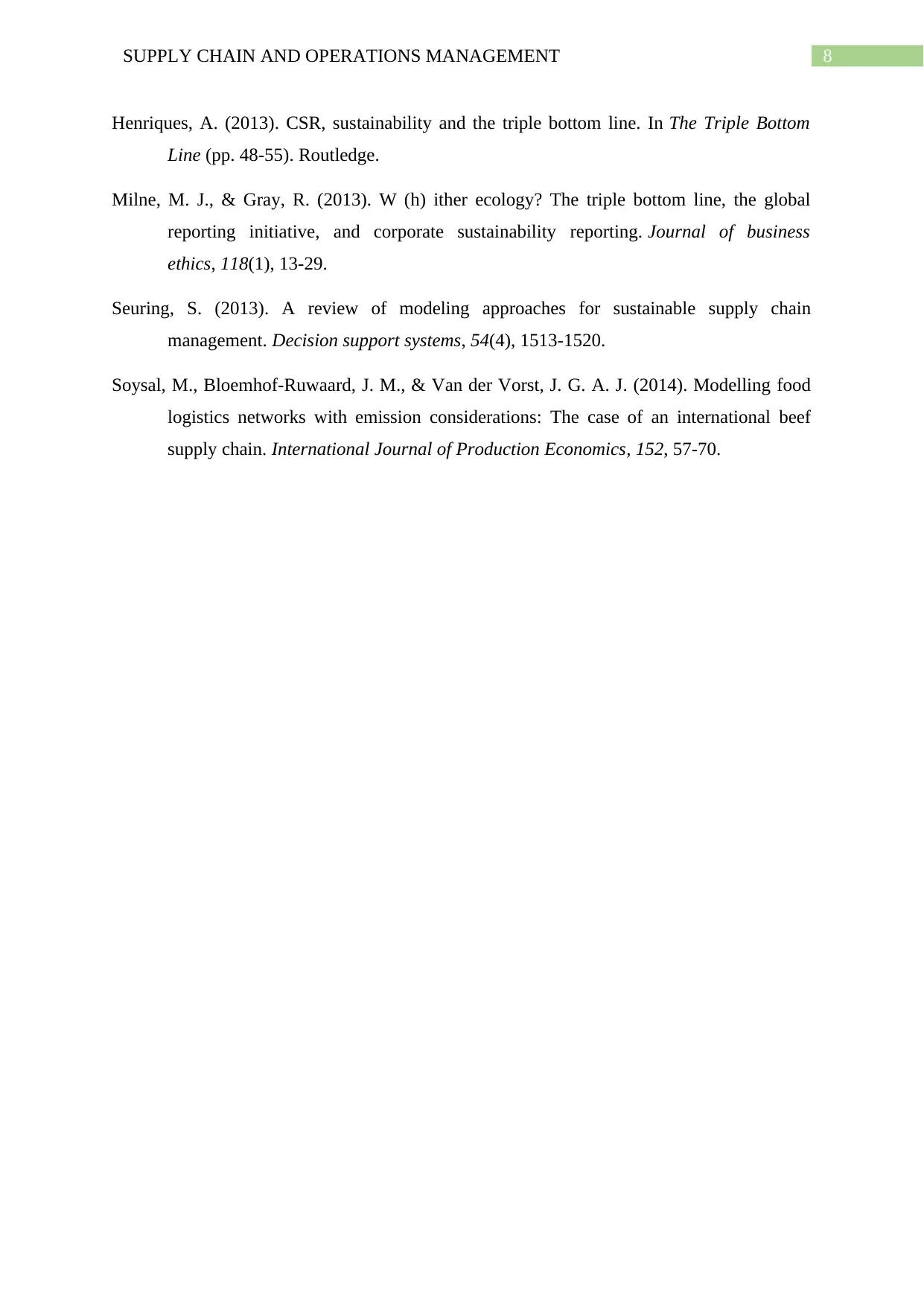
8SUPPLY CHAIN AND OPERATIONS MANAGEMENT
Henriques, A. (2013). CSR, sustainability and the triple bottom line. In The Triple Bottom
Line (pp. 48-55). Routledge.
Milne, M. J., & Gray, R. (2013). W (h) ither ecology? The triple bottom line, the global
reporting initiative, and corporate sustainability reporting. Journal of business
ethics, 118(1), 13-29.
Seuring, S. (2013). A review of modeling approaches for sustainable supply chain
management. Decision support systems, 54(4), 1513-1520.
Soysal, M., Bloemhof-Ruwaard, J. M., & Van der Vorst, J. G. A. J. (2014). Modelling food
logistics networks with emission considerations: The case of an international beef
supply chain. International Journal of Production Economics, 152, 57-70.
Henriques, A. (2013). CSR, sustainability and the triple bottom line. In The Triple Bottom
Line (pp. 48-55). Routledge.
Milne, M. J., & Gray, R. (2013). W (h) ither ecology? The triple bottom line, the global
reporting initiative, and corporate sustainability reporting. Journal of business
ethics, 118(1), 13-29.
Seuring, S. (2013). A review of modeling approaches for sustainable supply chain
management. Decision support systems, 54(4), 1513-1520.
Soysal, M., Bloemhof-Ruwaard, J. M., & Van der Vorst, J. G. A. J. (2014). Modelling food
logistics networks with emission considerations: The case of an international beef
supply chain. International Journal of Production Economics, 152, 57-70.
⊘ This is a preview!⊘
Do you want full access?
Subscribe today to unlock all pages.

Trusted by 1+ million students worldwide
1 out of 9
Related Documents
Your All-in-One AI-Powered Toolkit for Academic Success.
+13062052269
info@desklib.com
Available 24*7 on WhatsApp / Email
![[object Object]](/_next/static/media/star-bottom.7253800d.svg)
Unlock your academic potential
Copyright © 2020–2025 A2Z Services. All Rights Reserved. Developed and managed by ZUCOL.




